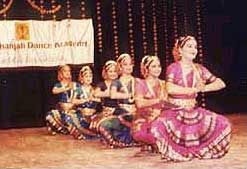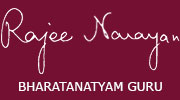REVIEWS
In Bombay, Rajee Narayan set up a school of dance called Geethanjali, where about a hundred students learn dance and music under her. Rajee has written the "Nritya Geeta Mala", a collection of her compositions. She includes an account of a jouney through dance with the help of music.
Although Rajee Narayan's music and dance are not often heard or seen these days, she is an important figure in Carnatic music and Bharatanatyam. She has carved a unique niche for herself in the history of Bharatanatyam by her untiring efforts at reforming this dance form. Hailing from a family of musicians, Rajee Narayan learnt music from her mother who was the first Indian woman to have broadcast Indian songs in the BBC. She had attracted attention even as a child artiste and continued to learn Carnatic music under Sulochana Mahadevan, her sister, and T. M. Rajagopala Sharma. The rigorous training she received moulded and shaped her voice. She has a vast repertory of compositions under her belt, and has perfected the Ragam Tanam Pallavi. She builds up each raga slowly and with great intensity of feeling. Rajee's knowledge of the theoretical and practical aspects of raga, tala and swara is the result of continuous life-long effort.
From music Rajee Narayan turned to dance. She received intensive training in Bharatanatyam under K Lalitha of the Saraswati Gana Nilayam, Madras and emerged as a dancer of repute.
"What induced you to change from music to dancing".
"There was no change as such because we were learning both. My sisters and I learned both dance and music. It is true that one of my sisters (Sulochana) liked music and another (Neela Balasubramanyam) opted for dance. I do believe now that my music and dance have reinforced each other".
Rajee gave her arangetram in dance when she was nine and in music when she was 14. After that she has given numerous concerts throughout South India. It is interesting to note that most of her dance performances were at military camps during World War II.
Through all this recognition, Rajee Narayan has remained simple and unassuming, neither indulging in false modesty nor in vain boasts. After her marriage in the early 1950s, she settled down in Madurai. Rajee's roles as a teacher came after the sudden demise of her husband Narayan. She migrated to Bombay in 1960, where she pursued her interests with diligence.
In Bombay, she set up a school of dance called Geethanjali, where about a hundred students learn dance and music under her.
She feels gratified that she has been made a member of The Board of Studies for Dance and Faculty of Fine Arts in Bombay University.
Rajee has written the "Nritya Geeta Mala", a collection of her compositions. She includes an account of a journey through dance with the help of music. Her book is available in three languages - Tamil, Devanagari and English - and contains 25 songs for Bharatanatyam with notation reinforced by solkattu sequences. The book should be of great help to Bharatanatyam dancers.
Rajee Narayan is grateful to her gurus and God for all that she has achieved. All her efforts have been preserving these rich art traditions.
Ravindra Misra
January 15, 1989.



